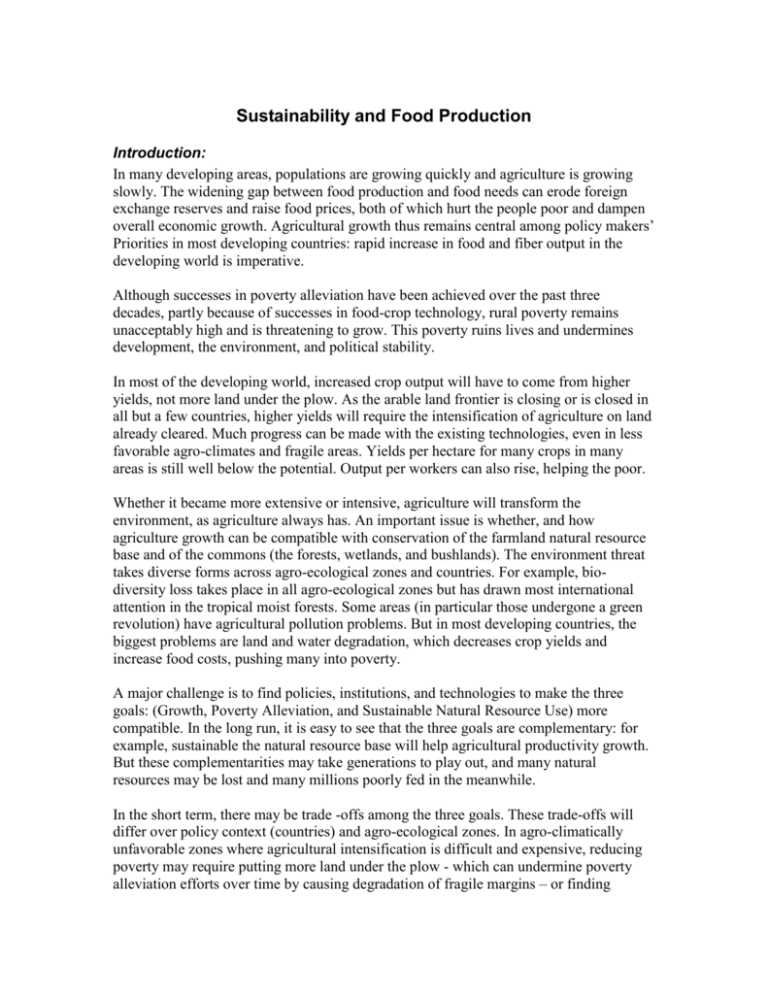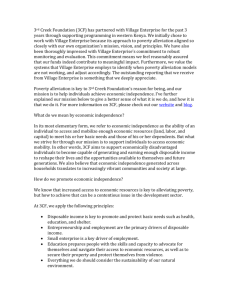In many developing areas, populations are growing quickly and
advertisement

Sustainability and Food Production Introduction: In many developing areas, populations are growing quickly and agriculture is growing slowly. The widening gap between food production and food needs can erode foreign exchange reserves and raise food prices, both of which hurt the people poor and dampen overall economic growth. Agricultural growth thus remains central among policy makers’ Priorities in most developing countries: rapid increase in food and fiber output in the developing world is imperative. Although successes in poverty alleviation have been achieved over the past three decades, partly because of successes in food-crop technology, rural poverty remains unacceptably high and is threatening to grow. This poverty ruins lives and undermines development, the environment, and political stability. In most of the developing world, increased crop output will have to come from higher yields, not more land under the plow. As the arable land frontier is closing or is closed in all but a few countries, higher yields will require the intensification of agriculture on land already cleared. Much progress can be made with the existing technologies, even in less favorable agro-climates and fragile areas. Yields per hectare for many crops in many areas is still well below the potential. Output per workers can also rise, helping the poor. Whether it became more extensive or intensive, agriculture will transform the environment, as agriculture always has. An important issue is whether, and how agriculture growth can be compatible with conservation of the farmland natural resource base and of the commons (the forests, wetlands, and bushlands). The environment threat takes diverse forms across agro-ecological zones and countries. For example, biodiversity loss takes place in all agro-ecological zones but has drawn most international attention in the tropical moist forests. Some areas (in particular those undergone a green revolution) have agricultural pollution problems. But in most developing countries, the biggest problems are land and water degradation, which decreases crop yields and increase food costs, pushing many into poverty. A major challenge is to find policies, institutions, and technologies to make the three goals: (Growth, Poverty Alleviation, and Sustainable Natural Resource Use) more compatible. In the long run, it is easy to see that the three goals are complementary: for example, sustainable the natural resource base will help agricultural productivity growth. But these complementarities may take generations to play out, and many natural resources may be lost and many millions poorly fed in the meanwhile. In the short term, there may be trade -offs among the three goals. These trade-offs will differ over policy context (countries) and agro-ecological zones. In agro-climatically unfavorable zones where agricultural intensification is difficult and expensive, reducing poverty may require putting more land under the plow - which can undermine poverty alleviation efforts over time by causing degradation of fragile margins – or finding alternative income sources. In agro-climatically more favorable zones, where cropping intensification is more practicable and sustainable, there is more potential to pursue growth without cultivating fragile hillsides, forests, or common grazing lands. Links among the three components: Sustainability, Growth and Poverty Alleviation: Sustainability – Growth Links: Issue: 1: It is not whether there should be agricultural growth or how fast it should be, but how to undertake such growth so that the natural resources base is not degraded. Issue 2: Agricultural growth needs to combine sustainability –whereby private and common land water resources are protected and degradation is stopped. Issue 3: Diversification economic activities and diversification of product mix on farms can be important to making growth and sustainability more compatible. Issue 4: Households and communities in a given region do not make decisions in a vacuum, and the results of their choices have repercussions beyond the boundaries of their farms or common areas. Poverty – Environment Links: Issue 1:Use of Natural Resources- if the resource base sustaining livelihoods is degraded and if restoration and conservation investments are not made, increased poverty is unavoidable. Issue 2. Health- Illness is an element of poverty. It may cause due to: i.) Intensification via Green Revolution- type of technical change in agriculture. ii.) Intensification to raise the output. In both, health and nutrition are affected by changes in food available per capita. Factors Conditioning the Links: Policies Technologies Institutions Population Pressure Agro-climatic Conditions Climate Change









